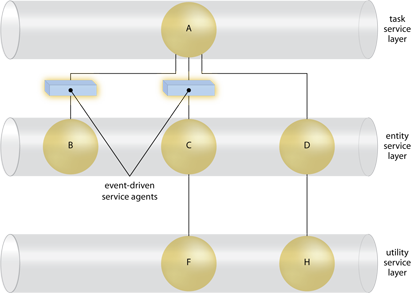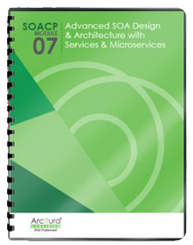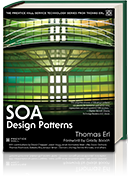SOA Patterns > Service Messaging Patterns > Service Agent
Service Agent (Erl)
How can event-driven logic be separated and governed independently?

Problem
Service compositions can become large and inefficient, especially when required to invoke granular capabilities across multiple services.
Solution
Event-driven logic can be deferred to event-driven programs that don’t require explicit invocation, thereby reducing the size and performance strain of service compositions.
Application
Service agents can be designed to automatically respond to predefined conditions without invocation via a published contract.
Impacts
The complexity of composition logic increases when it is distributed across services, and event-driven agents and reliance on service agents can further tie an inventory architecture to proprietary vendor technology.
Principles
Architecture
Inventory, Composition
 Two service agents replace the need for the explicit invocation of utility services E and G. By deferring common logic to service agents, the overall quantity of explicitly invoked services decreases.
Two service agents replace the need for the explicit invocation of utility services E and G. By deferring common logic to service agents, the overall quantity of explicitly invoked services decreases.
Related Patterns in This Catalog
Asynchronous Queuing, Atomic Service Transaction, Canonical Resources, Exception Shielding, Intermediate Routing, Message Screening, Messaging Metadata, Partial State Deferral, Partial Validation, Service Messaging, State Repository, UI Mediator, Utility Abstraction, Validation Abstraction
Related Patterns in Other Catalogs
Related Service-Oriented Computing Goals
This pattern is covered in SOACP Module 7: Advanced SOA Design & Architecture with Services & Microservices.
For more information regarding the SOA Certified Pofessional (SOACP) curriculum,
visit www.arcitura.com/soa.
This page contains excerpts from:
SOA Design Patterns by Thomas Erl
(ISBN: 0136135161, Hardcover, Full-Color, 400+ Illustrations, 865 pages)
For more information about this book, visit www.arcitura.com/books.

